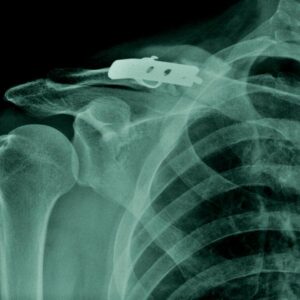Clavicle Fracture Specialist

Are you an athlete who participates in contact sports? If so, you may be at risk of sustaining a clavicle fracture. The clavicle can be injured during sports activities, a fall, or a motor vehicle accident. Clavicle fracture surgeon, Dr. James Mazzara provides diagnosis and both surgical and nonsurgical treatment options for patients in Manchester, South Windsor, Enfield, Glastonbury and surrounding Hartford communities who have sustained a clavicle fracture. Contact Dr. Mazzara’s team today!
Clavicle Fracture – Broken Collar Bone
What is a Clavicle Fracture?
The clavicle, or collar bone is part of the shoulder which connects the arm to the ribcage. Clavicles can easily be found at the base of the neck, extending out to the shoulders on each side. A clavicle fracture is when this long thin bone breaks from a direct blow, fall, accident, sports collision or work-related injury. The collar bone is the most common bone to break in the shoulder and Dr. James Mazzara, orthopedic shoulder specialist, serving Manchester, South Windsor, Enfield, Glastonbury and surrounding Hartford communities, has extensive experience in treating this type of injury.
Dr. Mazzara classifies a clavicle fracture into one of three groups:
- Group 1 Fracture – these are collarbone fractures that break in the middle third of the bone, where it is flat and thin. Sometimes referred to as midshaft fractures, they may be treated without surgery. The degree to which the bone is out of position can be seen on x-ray and will help Dr. Mazzara determine whether or not surgery is required to treat the fracture. Midshaft fractures are the most common clavicle fracture.
- Group 2 Fracture – also called lateral or distal fractures, occur near the acromion (a bony extension at the top of the shoulder) furthest away from the center of the body. 15-20% of clavicle fractures make up this group which may or may not require surgery, depending on bone displacement.
- Group 3 Fracture – Medial fractures are less common, responsible for only 2-4% of all clavicle fractures. This type of clavicle fracture occurs closer to the neck.
What are the Symptoms of a Clavicle Fracture?
- Pain and swelling. Sharp pain, especially at the time of injury.
- Pain when moving the arm.
- Swelling, tenderness and bruising over the bone.
- Stiffness in the shoulder that makes it difficult to lift the arm.
- Grinding sensation when trying to move the arm.
- Desire to hold the arm close to the body – supporting it with the uninjured arm.
- Deformity or “bump” over the break.
- The affected shoulder sags downward or forward.
How is a Broken Collarbone Diagnosed?
Dr. James Mazzara will ask for a history, especially the circumstances leading up to the injury. He will ask about the symptoms and then conduct a thorough examination of the shoulder. An x-ray will confirm the diagnosis and a CT scan or MRI may be ordered to provide Dr. Mazzara with more information on the overall condition of the shoulder and connective tissues. Patients in the Manchester, South Windsor, Enfield, Glastonbury and surrounding Hartford communities have access to the excellent, experienced team of orthopedic shoulder specialists in Dr. Mazzara’s office.
How is a Broken Clavicle Treated?
Non-surgical
If the broken collarbone has not shifted out of place or fragmented, surgery may not be required. An arm sling is used for comfort, immediately following a break and to keep the arm immobile while healing. Pain medication and other medicine may be prescribed to promote healing and minimize pain. In office evaluations and x-rays are usually performed every 3 weeks until fracture healing is confirmed. Moving the shoulder before the fracture is healed can cause a delay in healing. Working the joint too early can lead to a nonunion of the fracture which will cause the need for surgical repair.
Dr. Mazzara will only prescribe physical therapy once the break is healed. Physical therapy is then highly recommended to restore full function and range of motion. Patients begin with easier movements to ease stiffness, then will build up to more intense exercise as the bone heals.
Surgical
If the bones of the fractured clavicle are not in their correct anatomical position, as in a displaced fracture, surgery may be necessary. Surgery typically involves realigning the broken pieces and holding them in place with special metal hardware. Pins, plates and screws are often used during the surgical process.
When will my Broken Collarbone Feel Better?
Patients heal at different rates. Age, underlying health conditions and level of activity can affect the overall healing speed of a clavicle fracture. Patients with diabetes or who use tobacco-based products experience the longest healing time. Most often, patients heal between six and twelve weeks. It’s important to follow Dr. Mazzara’s instructions and to participate in physical therapy when recommended. Contact sports should be avoided for two to four months after a broken clavicle.
You are ready to return to your normal activity when Dr. Mazzara has confirmed, via x-ray, that the fracture has healed properly and when there is no pain when moving the shoulder.
If you have questions, or if you have experienced a clavicle fracture or any other shoulder condition requiring a specialist, please contact the office of Dr. James Mazzara, serving Manchester, South Windsor, Enfield, Glastonbury and surrounding Hartford communities.

